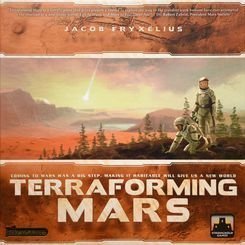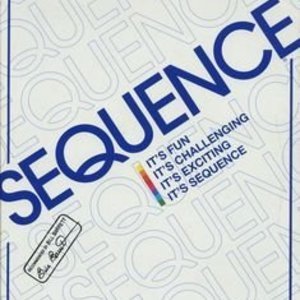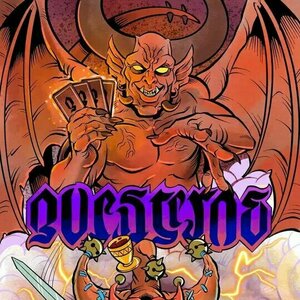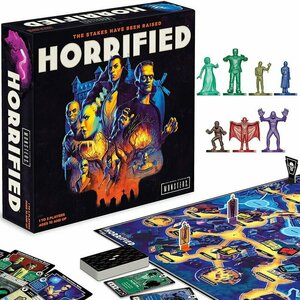Fred (860 KP) rated Terraforming Mars in Tabletop Games
Mar 6, 2018
Second game, I played against my wife & went for the cards & easily won.
Third game, I played against 4 players & again went for the cards. I got a lot of them & won the game easily. My friend, who had won the first game, said, "I was trying to get the cards with victory points, but I hardly got any. I played every one I got & only got a few points."
Fourth game. Played with my brother, his wife & my wife. Everyone played well, & we were pretty much even along the TR line. I got 3 of the milestones, giving me 15 victory points at the end of the game, which made my brother exclaim that it wasn't fair because he was going to get them, but each time, I went before him in the generation & that those 15 points would win me the game. He grabbed 3 of the awards, but only scored 12 points, while I scored 2 more points & my wife scored 7 points. Scoring for greenery, I got another 7 points. I was well ahead & thought victory was mine. We then started to count the points on our cards. As I was counting, I glanced up to see my brother moving his score cube past mine...way past mine. I thought that he must be cheating & he assured me that he had all these points. I looked at his cards & he had indeed all the points he said. I counted my points. 4. 4 points. What happened to my friend last game, had happened to me. I played every card I got that gave victory points & got 4 points. Actually, I had one more card that would have given me 3 more points, but I needed to already have a card that had a bacteria tag on it. But again, with the luck of the draw, I never got one to play, the entire game.
Now, there's nothing wrong with luck in games. I mean, every dice game is all luck. Every card game, is mostly luck. There is some strategy to the game, but it's basically play what you can to improve. And most people can figure this out & keep the game even. But with this game, every winner has won by at least 10 points & each has won with the points on cards alone.
While this may break a game for some people, I still find the game fun to play. I like the theme & I like the components. Even though the cards are thin & the ME(money) cubes are already flaking, I still like them. The luck factor is good in a way, as it means that one person can't be ridiculously good at the game & win every time. But this is not for everyone. My friend is very competitive & only wants to win. He's the kind of guy that goes online to find strategies on how to win, uses them, wins every game & thus ruins the game for everyone but him.
My bottom line is I like the game. It is one of my current favorites. The solo game is very good too. It's fairly quick, compared to the multi-player game. Less than half the time of the full game. I do recommend it to players who don't care too much about winning every game. You're not going to. Get used to it. Even though this is a major flaw for some, I'm still giving it 7 out of 10 for fun.
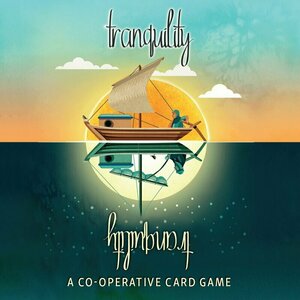
Tranquility
Tabletop Game
Jump on board the good ship Tranquility and set sail for paradise. Take care, though, because in a...
Sarah (7800 KP) rated Sequence in Tabletop Games
May 31, 2018
It works a little like Connect 4 with cards, but with a lot more detail and thinking involved. And like games like Monopoly, the cards you get are based solely on luck (of the draw/dice) and your strategy is what helps you win. But unlike most strategy games, Sequence is a fairly short one. It doesn’t drag on for hours (unless you spend a long time picking where to place pieces), and it doesn’t get boring. It can get a little frustrating at times, especially when you know you can have nothing to prevent your opponent from winning, but that’s all part of the game.
The only criticism is that despite stating it is for 2-12 players, it’s actually only for 3 players or 3 teams, as there’s only 3 different colours of chips. Whilst I understand that you can’t have a huge amount of players, surely 4 would’ve been a better and more appropriate number of players/teams/colours?
Despite this, it’s still a hugely addictive and fun game to play, I can’t see it getting old any time soon!

Mahjong Demon XL - Japanese Mahjong
Games
App
This is a Mahjong game of the Japanese style rule. Mahjong is the game to finish four Melds and one...
Nicole Hadley (380 KP) rated Laura Ingalls Is Ruining My Life in Books
Jun 18, 2018
The family recently relocated to Walnut Grove, one of the places Laura Ingalls grew up. It houses a Laura Ingalls museum that hosts an essay contest each year. In a spark of brilliance, Charlotte decides to enter the contests and win the grand prize of $500. She knows this money will change her family’s life and maybe help her mother put down some roots. As the contest deadline nears, Charlotte becomes very ill with the flu and misses over a week of school, and time to create her essay. At the last moment, she furiously scribbles out the line, “Laura Ingalls is ruining my life,” and turns that in as her essay. Her clever teacher reads this and probes Charlotte to write more and dig deeper.
The family rents out the basement of a house owned by Mia and Miguel, who live upstairs with their granddaughter, Julia. Charlotte has moved so many times that she is reluctant to learn the names of her fellow classmates or draw any attention to herself. After she is out sick at the very beginning of school, she starts to notice that her brother has made a lot of friends in her absence. Charlotte, however, is still uncomfortable and even fails a reading test so that she has to spend her lunch time doing remedial work. She hopes to win an essay contest about Wilder because the $500 would be helpful to her family, but Julia wins instead. The two girls start to volunteer at the Wilder museum, and start to become friends. Charlotte’s mother is writing very little, and as the year progresses, starts to slip into a significant depression. Rose’s father remarries, and Rose is devastated that he no longer schedules any of their visits together. When there is vandalism at the museum, Charlotte is blamed, but the real perpetrator is not any of the people who are suspected.
I recommend this book for any fans of pioneer life, Laura Ingalls Wilder, and middle grade readers. I received this book as an ARC from NetGalley via Macmillan Children’s Publishing Group and Roaring Brook Press.
Purple Phoenix Games (2266 KP) rated Questeros in Tabletop Games
Jan 21, 2021
Ero is the goblin court jester from the open who has been “chosen” to quest about the land to rid it of the ne’er-do-wells of the realm. In this solo adventure mode of Questeros the player will be donning the visage and character of Ero as they travel about developing their skills and having encounters with powerful beings. It is up to the player to guide Ero through the kingdom and rid it of the foul that is plaguing it.
DISCLAIMER: We were provided a prototype copy of this game for the purposes of this review. These are preview copy components, and I do not know for sure if the final components will be any different from these shown. Also, it is not my intention to detail every rule in the game, as there are just too many. You are invited to download the rulebook, back the game through the Kickstarter campaign, or through any retailers stocking it after fulfillment. -T
To setup the solo game, fondly and ingeniously-named “Ero’s Quest,” follow the rulebook to divide the tarot cards into their specific stacks and splays so that it roughly imitates the photo below. Draw a hand of five cards from the deck and the game may begin.
On a turn the player has a choice of seven actions that may be performed in any order. Each action may only be performed once per turn and when the turn is over the final action is Rest. To use the Develop action the player will place a card from their hand onto the Blades, Staves, or Orbs stacks in next-numerical order. This increases Ero’s attack and spending power. To Puchase cards Ero will spend Orb cards to look at the spent Orb value worth of cards from the draw deck, add one to their hand, and place the others at the bottom of the draw deck. At times Ero will need to Forget cards from hand in order to make room for more cards to enter it via the Learn action. Forgetting simply discards cards from hand while learning draws cards into hand from the draw deck. Recover is used to stand any kneeling/turned/rotated cards into an unused state by destroying cards of higher value from hand. As stated previously, to Rest is to end the turn by discarding the top card of the draw deck to setup the next turn.
I purposely left out the final action choice, Encounter, for a specific reason. Ero’s Quest is won when the entire deck of 21 Encounter cards is defeated. Each of these cards depicts a person or persons that Ero meets in his travels. Some require Ero to give them cards in order to pass. Some require Ero to succeed in battle against them in order to progress. In either case, Ero will need to get through the entire deck before his draw deck runs out in order to win the game.
Battle in Ero’s Quest is turn-based, where the Encounter persona attacks first, thus handing Ero wounds immediately. Wounds are suffered by spending Cups cards in value of the wound taken. For example, the Assassin is a value of 12, so they immediately wound Ero for 12 damage at the start of the encounter. Ero will spend a value of 12 Cups cards to simulate damage taken. Ero may then attack with a combination of available Blades, Staves, and any Ally cards obtained – one of each per attack turn. If the Encounter is defeated, Ero lives on. If the Encounter is not yet defeated, the battle continues with the Encounter card dealing damage and Ero responding with damage until one is defeated.
As mentioned earlier, the Encounter deck contains 21 cards with six of these being combat encounters. Ero has a ton of work to do and when each turn requires a card to be discarded before a new round may begin, they also have an in-game clock ticking and ticking each turn. However, if Ero is able to Develop their skills and overcome all the Encounters, the game is won and Ero becomes a Hero.
Components. Again, this is a prototype copy of the game, and many items are not fully completed in this version. That said, what we were provided is a large stack of tarot-sized cards, a first player Ero token (for multiplayer games), and a large pad of scoring sheets (also for multiplayer use). The cards are great quality and feature some really excellent artwork (on the cards that have the completed artwork on them). I do like the art style employed here, as I am a fan of fantasy themes, and I know that the game will probably ship with similar iconography, but may also be color-coded for ease of reference. All in all I believe Questeros is headed in the right direction for components, and a successful Kickstarter campaign may improve that even further.
The gameplay for the solo adventure of Ero’s Quest is really decent and engaging. So often I have found myself crunching numbers in my head and attempting to utilize my horrible card-counting “skills” to determine my next actions to take. Turns can be very intense and fruitful, or very frustrating and minimal, especially when you are waiting to draw that 3 of Blades so you can place it on the 2 of Blades sitting there, but it just won’t come up. And here you are sitting with the 4, 5, and 6 of Blades in hand and a Necromancer staring right at you awaiting combat. That is the definition of frustrating, but games usually take less than an hour, so even if an entire game is chock full of these turns, you can always setup a new game quickly and hope for better luck.
I like this one. I really do. It is interesting, has a great theme, so many delicious choices, and multiple ways to use the cards for game modes or tarot decks or even RPG FATE decks! On versatility alone I would rate this one high. If you are looking for a little card game to satisfy your mid-weight solo thirst, then check out Questeros. If you need a tarot game in your collection (as I look at mine and see no others), consider this one. It takes up very little shelf space, but looks great on the table and offers a great little solo experience. I have yet to beat the solo adventure, but Ero is calling my name for another go, and I might just have to give in. Again. And again.

Winning Marriage: The Inside Story of How Same-Sex Couples Took on the Politicians and Pundits-and Won
Marc Solomon and Deval Patrick
Book
Ten years ago no state allowed same-sex couples to marry, support for gay marriage nationwide...
Matthew Krueger (10051 KP) rated Horrified: Universal Monsters Strategy Board Game in Tabletop Games
Jul 31, 2020 (Updated Aug 1, 2020)
The Gameplay:
Horrified is a cooperative game in which all the players win or lose together. The players win if they defeat all of the Monsters they are playing against. In order to defeat a Monster, you must first complete a task.
Each Monster's task and subsequent defeat is unique:
Creature from the Black Lagoon: Find the Creature's hidden lair, then drive the Creature away.
Dracula: Smash Dracula's four coffins, then overcome Dracula.
Frankenstein and the Bride: Teach Frankenstein and the Bride what it means to be human so they can live peacefully.
The Invisible Man: Supply evidence to the police of the Invisible Man's existence, then trap him.
The Mummy: Break the Mummy's curse, then return him to his tomb.
The Wolf Man: Discover the cure for lycanthropy, then administer it to the Wolf Man.
The players lose immediately if one of the following occurs:
Terror: Each time a Hero or Villager is defeated, the Terror Level will increase. If the Terror Level reaches its maximum, indicated by the skull, the Monsters have overrun the village and the players lose.
Out Of Time: Each turn, you will draw a card from the Monster deck. If you need to draw a Monster card but the deck is empty, you have taken too long to defeat the Monsters and the players lose.
Each turn has two phases, performed in this order:
Hero Phase: Take as many actions as indicated on your Badge. In addition, any player may play any number of Perk cards.
Monster Phase: Draw one Monster card from the top of the Monster deck and resolve all three parts of the card. After completing both phases, play proceeds clockwise, starting with the next player's Hero Phase.
Hero Phase: Actions: Take up to the number of actions indicated on your Badge. You may choose to take fewer. Actions may be taken multiple times and in any order. The possible actions are:
Move: Move your Hero along a lit path to an adjacent space. You cannot move to water spaces and can only cross the river using one of the two bridge spaces. In addition, you may take any number of Villagers in your Hero's space with you when you move.
Guide: Move one Villager from your Hero's space to an adjacent space, or move one Villager from an adjacent space to your Hero's space. Villagers also cannot move to water spaces, and Monsters do not affect their movement.
Special Action: Some Heroes have a special action, as indicated on their Badge. Just like other actions, special actions count as one of the total number of actions for your turn and can be taken multiple times.
Pick Up: Take any number of Items from your Hero's space. Keep all your Items in front of you, next to your Badge.
Share: All Heroes in the same space as your Hero may freely give or take any number of Items from each other.
Advance: At a specific location, use one of your Items to advance a Monster's task.
Defeat: In a Monster's space, use your Items to defeat that Monster.
Monster Phase:
Draw a card from the top of the Monster deck and resolve the three parts of the card, from top to bottom. After resolving the entire Monster card, put it in a discard pile face up.
1. Items: Draw the number of Items listed at the top of the card, if any, from the Item bag. Place each Item at the location indicated on the Item.
If you need to draw an Item when the Item bag is empty, place all the Items from the discard pile into the bag, mix them up, and continue drawing.
2. Event: Each Event either involves one of the Monsters or the Villagers.
The card's color, as well as the symbol above the Event's name, indicates who the Event is about. Gray cards are about the Villagers. Colored cards are about a specific Monster.
If the Event Monster is not in your game, completely ignore the Event and continue with the Monster Strike. Otherwise, read the Event out loud and do what it says.
3. Monster Strike: Certain Monsters move and attack, as indicated by the symbols at the bottom of the card. In order from left to right, move and attack with the first Monster before proceeding to the next Monster.
If an indicated Monster is not in your game, ignore that symbol. If the Frenzy symbol is shown, the Monster with the Frenzy Marker moves and attacks. This could result in the same Monster moving and attacking twice in one turn.
Move the Monster the number of spaces indicated on the card towards the closest person (Hero or Villager). As soon as the Monster is in a space with a person, they stop moving. If the Monster started in a space with a person, they don't move at all.
Attack one person in the Monster's space by rolling the number of attack dice indicated. If there are no people in the Monster's space, the Monster does not attack-do not roll dice. If there are multiple people in that space, the Monster will attack a Hero rather than a Villager.
If there are still multiple people the Monster could attack, the current player chooses one to attack before rolling.
Perk Cards: Each player starts the game with a Perk card, and more Perk cards can be earned by getting Villagers to their safe locations. Keep all your Perk cards face up in front of you. It's a good idea to discuss your Perk cards, and when to play them, with the other players.
Perks may be played on any player's turn, but only during the Hero Phase. When you play a Perk card, do what the card says, and then put it in a discard pile face up. Playing a Perk card does not take an action.
Items: Items are important for advancing tasks and defeating Monsters, as well as defending yourself from the Monsters' attacks. Each Item has a color, indicating its type, and a strength, which is the number at the top. Each Item also has a location, which indicates where the Item is placed when it is drawn from the Item bag.
Hit by a Monster:
Heroes: To ignore being hit by a Monster's attack, a Hero may discard one Item for each Hit symbol rolled. If the Hero does not have enough Items, or does not wish to discard any Items, they are defeated. One hit defeats a Hero.
When a Hero is defeated, increase the Terror Level by moving the Terror Marker one space and remove that Hero from the board.
At the start of that player's next turn, they place their Hero at the Hospital and take their turn as normal, including their full number of actions. A defeated Hero does not lose any Items or Perk cards.
Villagers: A Villager does not have any Items and is therefore defeated immediately when hit. When a Villager is defeated, increase the Terror Level by moving the Terror Marker one space and remove that Villager from the board.
End of the Game: The game can end in one of three ways:
Heroes Triumph: If you defeat all the Monsters, the game immediately ends and the players have won! You've saved the village from a horrific fate, and perhaps even the Monsters themselves.
Terror!: If the Terror Level reaches its maximum, indicated by the skull, the game immediately ends and the players have lost. Everyone, including the Heroes, are too horrified to continue. You abandon the village to the Monsters.
Out Of Time: If you need to draw a card when the Monster deck is empty, the game immediately ends and the players have lost. You've taken too long to save the village. The Villagers have fled and you aren't able to continue.
Solo Play: The Villagers are more fearful if there is only one Hero trying to save the village. Begin the game with the Terror Marker on the "3" of the Terror Level Track.
All the rules remain the same. However, do not play as the Courier-that Hero's Special Action cannot be taken in a solo game. Also the Perk cards "Special Delivery" and "Conduct An Investigation" cannot be used.
Either remove these cards before playing, or when drawn, immediately discard and draw a new Perk card to replace it.
Its a fantasic excellent strategy game based around the universal monsters. I love it so much its such a fun game. If you want to learn more go to BoardGameGeek, Dice Tower Review or One Stop Co-Op Shop.
Purple Phoenix Games (2266 KP) rated Tranquility in Tabletop Games
Oct 21, 2021
Tranquility is a cooperative hand management, tile placement card game for one to five players. In it players will be attempting to create a sea of islands around which they sail their boat towards infinite paradise. They will accomplish this by laying numbered cards from their hand in numerical order before any of the players run out of chances to play a card. Oh, and there’s also no talking during the game. That’s kind of a big deal.
DISCLAIMER: We were provided a copy of this game for the purposes of this review. This is a retail copy of the game, so what you see in these photos is exactly what would be received in your box. I do not intend to cover every single rule included in the rulebook, but will describe the overall game flow and major rule set so that our readers may get a sense of how the game plays. For more in depth rules, you may purchase a copy online or from your FLGS. -T
To setup the standard game, place all the border cards around a 6×6 grid, as in the photo below. Shuffle the appropriate number of Start and Finish cards into the deck of Island cards and place that beside the grid. Draw a hand of five cards and the game may begin. Setup is similar to the multiplayer setup, with a few changes. Once the hand of cards has been drawn, the game may begin! It is the solo player’s goal to build the sea of island cards, and place the Start and Finish cards before they run out of cards to be legally played.
The game is played over many turns. Each turn players will be either playing a card from hand or discarding two cards. When a player plays a card from hand to the grid, they may place it anywhere they wish within the grid. The goal is to have each card placed numerically in order beginning from the lower left of the grid in a zig-zag pattern left to right, then ascending to the next highest level. In other words, the play area would be ordered numerically as English-speaking people read, but from the bottom up instead of the top down – like a reverse typewriter.
When a card is played, the player may choose to place it in its own area, or immediately next to another card already in play. If the new card is placed adjacent to an existing card, the player must discard cards equal to the difference between the values of the two adjacent cards. For example, if a 12 is placed next to a 14, then the player would need to discard two cards after placement. If a card is placed that is already in direct numerical order, no discards are needed. Again, a card at the right-hand edge of a row is adjacent to the card on the next row higher on the left-hand edge, and this is the most difficult aspect of the game to grasp for new players.
Should a player instead wish to discard two cards for their turn, they do so to their discard pile. After each action (playing a card or discarding two cards) the player will draw back up to their hand of five cards.
Eventually, the player will happen across the Start and Finish cards. In the solo game, when a Start card is placed (outside the grid, but in amongst the border cards in the lower left-hand corner), the player will need to draw eight cards from the draw deck, keep four, and discard the remaining eight. This eats up cards from the draw pile and draws the game closer to the end. When the grid is completed and all the numbered cards are in numerical order, the player may then play the Finish card to end the game. If all cards are properly placed the player wins! If not, they must try again. Probably immediately, because it is that kind of game.
Components. This game is a bunch of square cards in a cubic box. Now, while that doesn’t sound super exciting, the art on the cards certainly make up for the lack of component diversity. Each card is matte finished, which I prefer for cards with great art on them. And oh man, that art is something wonderful! I have always been a fan of Tristam Rossin’s art, and it is on full display here. The cards are, well, I guess I cannot find the correct word because they aren’t double-sided, but split on the horizontal, with a daytime scene on the “top” and a nighttime scene on the “bottom” (or vice-versa, however you feel). I have nothing but praise for the components here.
The gameplay is familiar in feel, but definitely a little different and a whole lot of fun. Fans of The Mind will find this familiar in that the game is structured around silent players building a grid/stack of numerically appropriate cards until the win condition is met. However, I have not been able to play The Mind solo, and Tranquility comes with solo rules in the box. So that’s a win in my book.
Now, Tranquility solo is no cakewalk. No, there are no other players to make crazy decisions to throw off any tactics planned, but you most certainly can misjudge where to place a card, and then be married to its position as you try to fill in all the appropriate cards around it. I learned that all too early when I decided my first game that I should try to divide the grid into equal sections and approximate where a 48 should go. Well, I’ll tell you now that a 48 has absolutely no business being a row above a 19 (check the photo above if you don’t believe me). Silly choices like this make for an afternoon of pondering optimal placements when unboxing your next play, and that brings a smile to my face. Any time I think about a game the next day or several days later and it entices me to play again with a different strategy, I feel is the mark of a great game.
I have yet to play this with a group (damn COVID), but I know the people I play with are going to love this one. And, honestly, I am going to love the peace and quiet as the game plays out, so I can think about my turn and then think about a different possibility once someone ruins my plans. But I tell you what, even as a solo game, this one is great. I am quite happy to keep this as a pure solo experience, but I do want to try it once with others. We do not typically give out ratings for Solo Chronicles reviews, but this one would be pretty high, I’m telling you now. Okay, I have to go get the boat ready and pack my cooler. Enjoy Tranquility!

KICK: Football Card Trader
Sports and Games
App
Topps® KICK® 2018: Football Card Trader is the official digital card trading app of the Premier...
